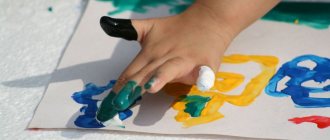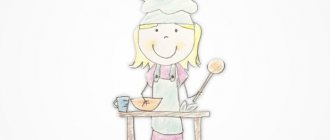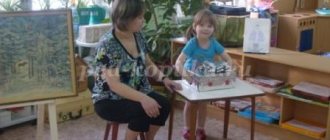Excursion to the mini-museum “Ecosystem “Forest” in the second junior group.
Summary of the excursion to the mini-museum “Ecosystem LES”
in the middle group No. 1
Tasks:
Social and communicative development:
promote the development of communication and interaction of the child with adults and peers; formation of readiness for joint activities with peers, the foundations of safe behavior in nature.
Cognitive
development
: formation of children's cognitive interests, curiosity and cognitive motivation; cognitive actions, the formation of primary ideas about the objects of the surrounding world (the ecological system of the Forest), about the features of the native nature; development of imagination and creative activity.
Speech
development: update the active dictionary; development of coherent, grammatically correct dialogical and monologue speech.
Artistic and aesthetic
development: formation of prerequisites for value-semantic perception and understanding, aesthetic attitude towards nature; perception of fiction about the forest and its inhabitants; implementation of independent creative constructive and modeling activities of children when playing with models.
Physical
development: acquiring experience in children’s motor activity.
At the entrance to the museum, children are greeted by a white bunny. He invites the children to visit
.
Hare. Guys, tell me why am I white?
Children (There is still a lot of snow, it’s cold)
Hare. Do you know what hares eat in the forest in winter?
Children. Tree bark
Hare. I invite you to the forest. We placed trees in our forest. What trees can you find in the forest?
Children. (Spruce, pine, birch).
Hall 1
.
Environmental campaign “Save the Christmas tree”
There are many different Christmas trees in our museum. On New Year's Eve, trees are cut down. What do you think, is it necessary to cut down the forest beauty? What can replace the Christmas tree? Why are we doing this?
Children. You can make different Christmas trees for the holiday with your own hands.
Hare. These are how beautiful our Christmas trees are. Made of mesh, knitted, Christmas tree with friends, made of cotton pads, made of wood. The children and their parents made them for us. Did you like them?
Children. Yes
Hare Next New Year, you and your mothers will make the most beautiful Christmas tree with your own hands. With this you will save the forest beauties.
Hall 2.
Large hall “Ecosystem LES”
Here we look at trees, find similarities between trees and their differences. Let's find out who needs trees in the forest. What floors are there in the forest and who lives on them. How many bears are there in our forest? Bunnies? Foxes? Right. Here we act out fairy tales about animals.
Hare. And here we collected the gifts of the forest. Look at the exhibits, here is the white bark with stripes. Whose bark is this? (Birch trees) And this dark bark? (Poplar)
Hare. There are cones in our museum. They are different, some are prickly, others are smooth. (Hand out the cones). Pick up the big bump, pick up the little bump. Different trees have different cones. There are a lot of nuts in pine cones. They are tasty, nutritious, and contain a lot of vitamins.
Hare. But on this shelf there are collected wood products. Pencils, houses, toys, paper crafts, big chicken (origami), sandals.
Look at our books about the forest, they have large and bright pictures.
Game "Tree"
introduces us to changes in nature and in the life of trees. There are roots, branches, a hollow. Who lives in a hollow? There are holes near the tree. Who lives in minks?
Children. Foxes live in minks, hedgehogs sleep in winter, and a bear sleeps in a den.
Educator: Do animals need trees?
Didactic game “Who eats what?”
Educator: And here we have a very interesting game. It's called "Who's Eating Whom?" (Food chains). I take the grass, put it on the table, spikelets have grown in the grass, who eats the spikelets and seeds? (Mouse). Who eats mice? Guess, a big bird, round eyes, sleeps during the day, flies at night, catches mice. Who is she? (Owl)
The chain “grass, spikelet, mouse, owl” is disassembled
Does the owl need grass? (No) What about the spikelets? (No) Can mice live without grass? (No) They all need each other. One cannot live without the other.
It is explained that the owl also needs grass in the field, that in nature everything is interconnected.
Bottom line.
Hare. Did you like our museum? (Children's answers) Will you come to visit us in our museum?
We will be very glad to see you. And now I’ll run and tell everyone in the forest about how great you are. The days will be warm soon, it’s time for me to change my fur coat.
Summary of the excursion “Journey through the kindergarten” for children of primary preschool age 3-4 years
Summary of the excursion “A Journey through Kindergarten”
for children of primary preschool age 3-4 years old
Develop interest in the work of adults.
Educational:
Strengthen children's knowledge about the workplace of preschool employees. Teach children to formulate a question.
Developmental
: Develop active verbal communication skills, teach children to value the work and care of adults, apply the acquired knowledge in productive and other activities.
Educational
: To instill in children a respectful attitude towards kindergarten staff and their work.
Conversation with children “Who takes care of us?”, looking at illustrations of “Professions”, an evening of riddles and guesses.
Plan for employees to talk about their activities.
What kind of work does it do?
What kind of headdress does he wear?
Tools he uses?
Course of the excursion (in a group):
Educator:
You know that many adults work in kindergarten. They take care of you, try to make you feel good, happy and comfortable. And our first and most important assistant is the junior teacher. What's his name? What is she doing? (Children's answers.) The junior teacher's story about his activities (according to the proposed plan).
Educator:
What are the names of your teachers? What are they doing? (Children's answers). The teacher's story about his activities.
Educator:
Do you want to meet and find out who else works in kindergarten? Let's go on a trip. What will we go on? (Children's suggestions).
By train. Take your seats in the carriages. (Here our train is moving, the wheels are knocking.....)
Educator:
The very first office is an office in which adults in white coats work. “Who works here?” (Children's answers).
Educator:
That's right - a doctor and a nurse. Shall we meet them? And now I’ll ask the adults: “What’s your name?” (Answers from adults)
Educator:
Ask, Dasha. (What is your name?) (Answers from adults).
Educator:
Tell us about your profession. Adults talk about their activities. Thank you very much. And the guys and I will move on. Take your seats in the carriages. The journey continues.
Educator:
What kind of office is this? Look, there are also adults in white coats here. Maybe this is also a medical office? (Children's answers).
Educator:
Correctly called FOOTER BLOCK. There are many rooms here. Before entering, we need to put on overalls. (We put on aprons, scarves, and caps for children). How many adults work? (A lot of). What is the name of the profession of these adults? (Children's answers). What do you want to know from chefs? (Children's questions)
Educator:
Thank you very much. And we continue our journey. Zinaida Romanovna meets us. What is she doing? (Children's answers). Name the laundry assistants. (Iron...) The washerwoman’s story about her activities.
Educator:
Thank you very much. And we need to return to the group. How can you quickly get to the group? (By plane). Take your seats. We start the engine. Let's fly.
Educator:
Did you enjoy traveling? Do you want to know who works in kindergarten? Next time we will find out who is the most important person in our kindergarten and what he does.
Abstract “Targeted walk along the summer ecological trail” in the 2nd junior group
author: Gayanova Gulfiya Nikolaevna
Teacher of MDOBU kindergarten No. 1
Abstract “Targeted walk along the summer ecological trail” in the 2nd junior group
Municipal preschool educational budgetary institution
kindergarten No. 1
ABSTRACT
gaming activities classes
Subject: "
Targeted walk along the summer ecological trail
"
in the 2nd junior group
In MDOBU kindergarten No. 1 r.p. Chunsky
Compiled by: Educator
Gayanova G.N.
Lesson notes on gaming activities
Topic: “Targeted walk along the summer ecological trail”
Program content:
- Develop the ability to recognize and name plants of their native land; develop speech, thinking, observation; ability to conduct dialogue.
- Nurture aesthetic feelings; emotional responsiveness to the beauty of the native land; respect for nature.
- To consolidate knowledge about the adaptation of wildlife to seasonal changes; learn to identify the signs of summer.
Preliminary work:
- Route development.
- Memorizing poems.
- Selection of games, riddles.
Material:
- Basket.
- Envelope with a letter.
Surprise moment.
Contents of the walk.
Educator: Guys, look around! Pay attention to the nature around us! How beautiful it is all around, no matter where you look! Tell me, what time of year is it now? (Children's answers). That's right, summer! The brightest and warmest time of the year. Listen to how poetess Elena Trutneva beautifully described summer:
SUMMER.
If there are thunderstorms in the sky, if the grass has bloomed,
If early in the morning the dew bends the blades of grass to the ground,
If in the groves above the viburnum there is a hum of bees until the night,
If the sun warms all the water in the river to the bottom,
So it's already summer! So spring is over!
Guys, what signs of summer do you know, name them? (Children's statements). Very good, well done! Today we will go for a walk in a very interesting country full of secrets and mysteries. Look and listen carefully in a circle. You will learn a lot of new and interesting things today. Let's first greet the world around us.
Invented by someone simply and wisely
When meeting, greet “Good morning!”
Good morning to the sun and the birds,
Good morning to smiling faces!
Smile at each other, give your smiles to those around you!
Let's hit the road. You will find out our first stop if you guess the riddle:
They drink me, they pour me out.
Everyone needs me!
Who am I? (Water)
Educator: Well done, you guessed right. Guys, do you know about the benefits of water? (Children's reasoning). Right. Everyone needs water: people, plants, and animals. Without water, all living things around us will die. We have two beautiful fountains in our garden. They decorate the territory of our kindergarten, and sometimes birds come here to drink water. And look what a beautiful flower has grown and is swaying in this small pond. what is it called? (Children's answers). That's right, water lily! (Child reading Ekaterina Serova’s poem “Water Lily”):
A water lily lies on a leaf,
Like on an elastic raft.
And I would float down the river
To thoughtful friends.
But here's the problem - the raft is tied,
He won't go anywhere.
Educator: guys, do you know that water is a home for some animals? Who lives in the water? (Children's answers). Well done, you know everything and answered correctly. Well, what do we go next? Now you can guess where we will stop. Guess the riddle:
I'm capricious and tender
Needed for any holiday
I can be white, yellow, red,
But I always remain beautiful! (Rose).
Educator: guys, let's look carefully at these flowers. For now they only have buds, but time will pass and beautiful, fragrant flowers will bloom. Who knows how to care for flowers? (Children's answers). Right! You need to loosen the soil, water it, cut off dried leaves. What other flowers do you know? (Children's answers). Well done! How many colors do you know? And I suggest you play a little and turn into wildflowers - cornflowers. Let's start the transformation!
Blue stars fell from the sky. (Children squat).
The forest looks at them in fascination (They rise on their tiptoes, swing their arms from side to side).
The wind quietly circles above them, (They spin around in place)
Looks at the blue stars in the rye,
Gently shakes a wave of cornflowers, (They shake again with raised hands)
Magical flowers as blue as stars.
Educator: how well we had a rest! How many beautiful cornflower flowers have grown in our clearing! Let's go on for a walk.
Pay attention to the Christmas trees, what do we know about the Christmas tree? Children's answers
Look, which fairy tale heroes settled under the Christmas tree? (Children's answers). Oh! What is this fox holding in his mouth? Some kind of letter. Let's get a look. (Reading a letter from the Queen of Summer)
Educator: our journey has ended. What do you remember most? (Children's statements). It's time for us to return to the group. Let's go back on the train. Take your seats in the trailers.
Excursion progress
The teacher draws the children's attention to the kindergarten . It's two stories high. The kindergarten is very large . It has 2 main entrances. in the kindergarten . This is because there are many groups and different rooms . The teacher shows the children the windows of their group .
Around the building there are flower beds with beautiful and bright flowers. There are many large trees in the garden In summer they protect children from the sun.
On the territory of the kindergarten there are many areas with various buildings: sandboxes, houses, cars, ships, buses, swings, benches and benches. Adults did all this for children because they love children and care about them. Everything made by human hands must be protected.
Together with the children, the teacher examines the plants on the site, flower beds, and a vegetable garden. He asks the children why there are so many trees and bushes here. It reminds me that all this was planted by adults to make the site beautiful, that they took care of the children.
The teacher explains that there are a lot of kindergartens , in each kindergarten adults plant many different plants, and our streets become very beautiful.
The teacher invites the children to remember the name of the street on which the kindergarten . He asks what plants are planted there and asks to name them.
1. On what street is our kindergarten ?
2. What did you see on the way to the site?
3. What grows on our site?
4. What was built on the site?
5. Why is it forbidden to destroy buildings or tear up plants?
Improvement of the territory of the kindergarten It is not without reason that the kindergarten is called the second home for preschool children. Here kids spend most of their day, here they develop, communicate,...
Summary of the didactic game “Who works in kindergarten?” (name of professions of kindergarten workers) (junior group) Goal: to deepen and clarify children’s ideas about kindergarten. To consolidate knowledge of the names of professions of kindergarten employees. Bring up.
Abstract of the educational activity “Acquaintance with the premises of the kindergarten (music and physical education hall)” (junior group) Purpose: to teach children to navigate some of the premises of the kindergarten (music hall, physical education hall). Cultivate kindness.



